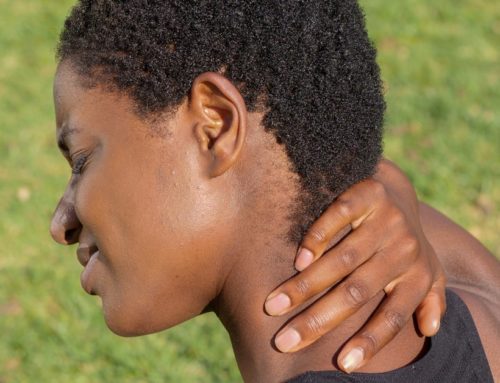You may have noticed that you aren’t standing quite as tall as you used to. Your shoulders and neck look slightly (or more than slightly) hunched forward when viewed from the side. Maybe your pelvis juts forward too. Even before these visual signs emerge, you may feel chronic aches and pains in your upper back and neck or lower back and hips. These are all symptoms of posture problems. Here at Burkhart Chiropractic, we often see patients who are struggling with pain because of poor posture. You can improve your posture and get rid of your pain in 3 easy steps. Here’s How:

1. Identify the Cause
Posture problems can be caused by lifestyle habits, trauma, and disease. The first step to correcting your posture is to figure out what’s causing it. This may be obvious to you. For instance, you might know that you have a whiplash injury from an auto accident or that you tend to slouch at work. Or you may suspect you have arthritis in your spine that’s causing degeneration.
Sometimes people aren’t sure what’s causing the problem. In either case, discussing your lifestyle, medical history, and any accidents you’ve been involved in with our chiropractic team is a good idea. We can evaluate your posture and even take x rays to determine where injuries or degeneration have left their mark. Once we know what’s causing the problem, we can give you personalized advice on how to avoid aggravating it (like how to set up an ergonomic workspace) and create a treatment plan for you.

2. Correct the Damage
As we’ve mentioned above, your treatment plan will look different depending on the cause of your posture problems. Correction of poor posture requires exercises to strengthen certain muscle groups and ease tense ligaments. Many people have musculoskeletal damage from posture problems that have gone uncorrected for months or years. Other treatments, like chiropractic adjustments, may be added to your exercise sessions to heal this damage. Both steps are necessary. Without treatment for underlying damage, posture changes may be more difficult, and you might keep experiencing pain. If the posture is not corrected, the damage will reoccur.
Here are the three most common causes of poor posture and related injuries, and what a treatment plan might look like for each:
Lifestyle Habits: If your posture problems have been caused by lifestyle habits such as too much sitting or hunching forward at your desk, you may have some subluxations that need to be treated. A subluxation is when your vertebrae are out of alignment. Chiropractic adjustment can correct subluxations and may be necessary throughout your treatment process. Tight ligaments and shortened muscles are also common in patients with unhealthy posture habits. During your posture rehab, we will use simple exercises to ease these tight muscles and ligaments. This will allow you to adopt a healthy posture more easily and will ease aches and pains. Sitting every day can also weaken your core. We include core strengthening exercises in our posture rehab program to help improve balance and stability. Strong core muscles allow you to maintain a healthy posture and will prevent subluxations.
Whiplash or Other Injuries: In the case of an injury that has caused a posture problem, treatment will focus on the injured area and any other areas affected by the misalignment. Whiplash injuries straighten the neck’s curve and put a strain on ligaments and muscles in the neck, shoulders, and upper back. Chiropractic adjustment combined with posture correction exercises can restore the cervical spine’s natural curve and ease strained muscles and ligaments. We may recommend other treatments like cold laser therapy or acoustic compression therapy to help speed healing or break up scar tissue.
Other Forms of Degeneration: Posture problems related to aging or disease will use similar treatment protocols to those described above. If a chiropractic adjustment is necessary, our experts can use gentle techniques appropriate for arthritis patients and those with thinning bones. Posture exercises can be modified to treat a variety of age groups and abilities. Your safety and comfort are always our first priority.
Our posture rehab exercise sessions usually last between 15 and 30 minutes. We use the most up to date technology, including a motion guidance tool that adds visual feedback and external cues to your rehab session. Our patients find that this tool helps them to understand better how their body moves. It is especially helpful for those struggling with stiffness and limited range of motion.

3. Prevent Reoccurrence
Posture problems often form over a long period of time. Treatment also needs to continue for longer than your office visits. Our team will give you easy to follow instructions on quick exercise routines you can do every day at home to maintain the progress you’ve made. We’ll also give you lifestyle advice to help you keep your posture healthy throughout your daily activities.
We believe in providing a one-stop solution for posture problems and the injuries associated with them. In pursuit of this goal, we provide state of the art foot scanning and custom orthotics for our patients. Flat feet and differences in leg length are common conditions that aggravate posture problems. Our custom orthotics support all three arches in the foot and help to align the knees, hips, and shoulders. Orthotics are not necessary for everyone, but they are a vital part of continued recovery at home for many patients.
With the right posture rehab treatment and at-home care, you can improve your balance, relieve your pain, and increase your range of motion.





